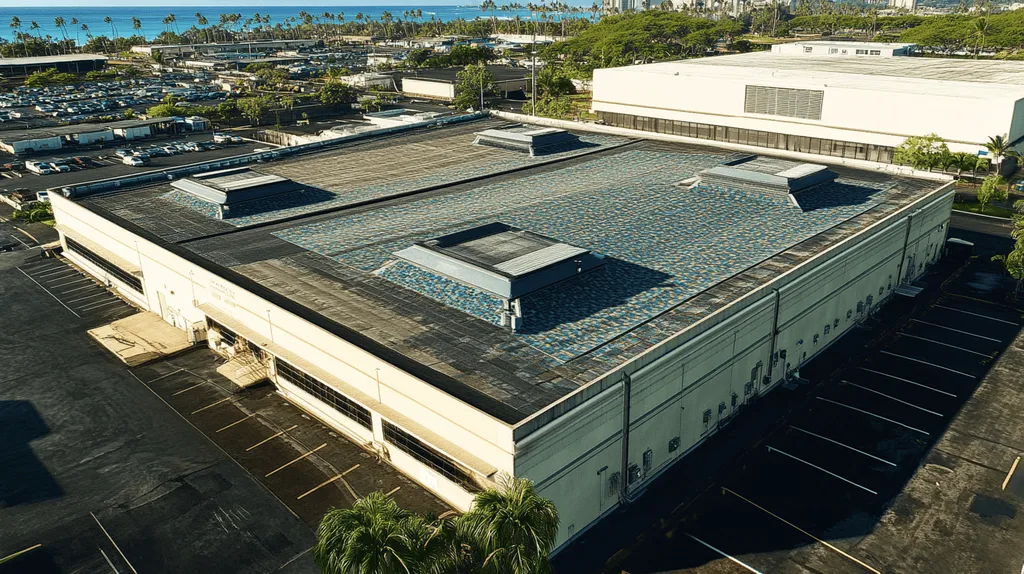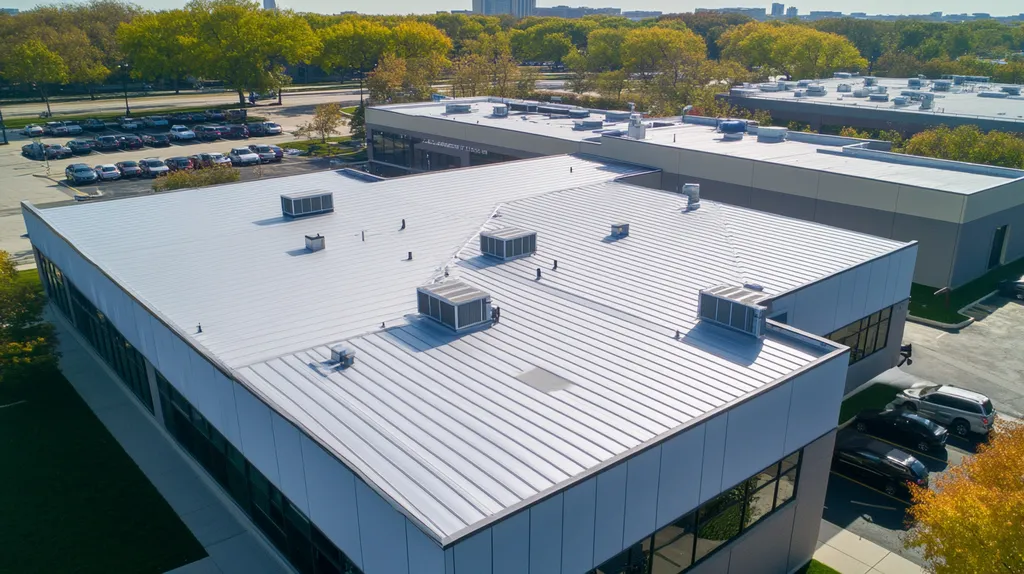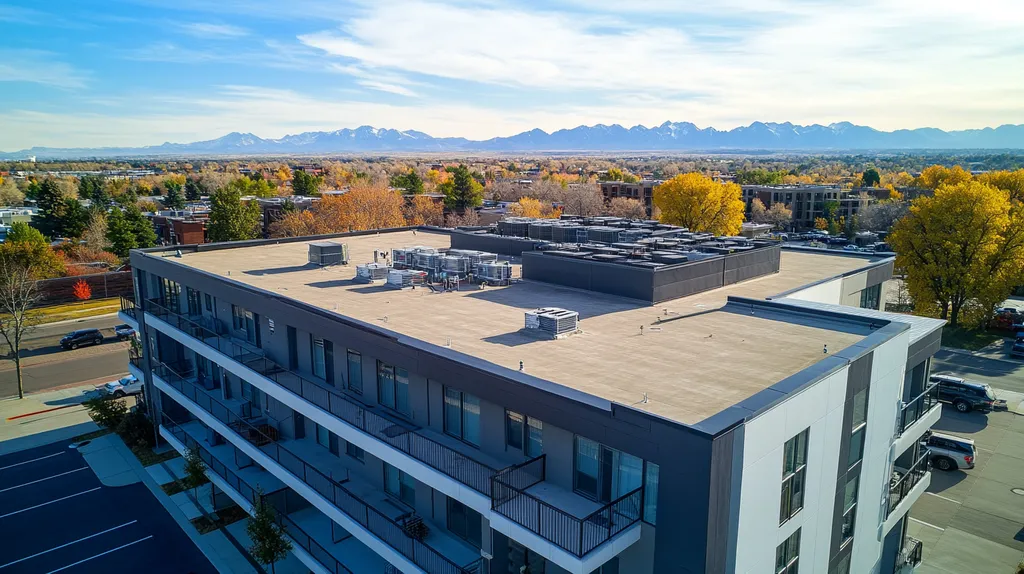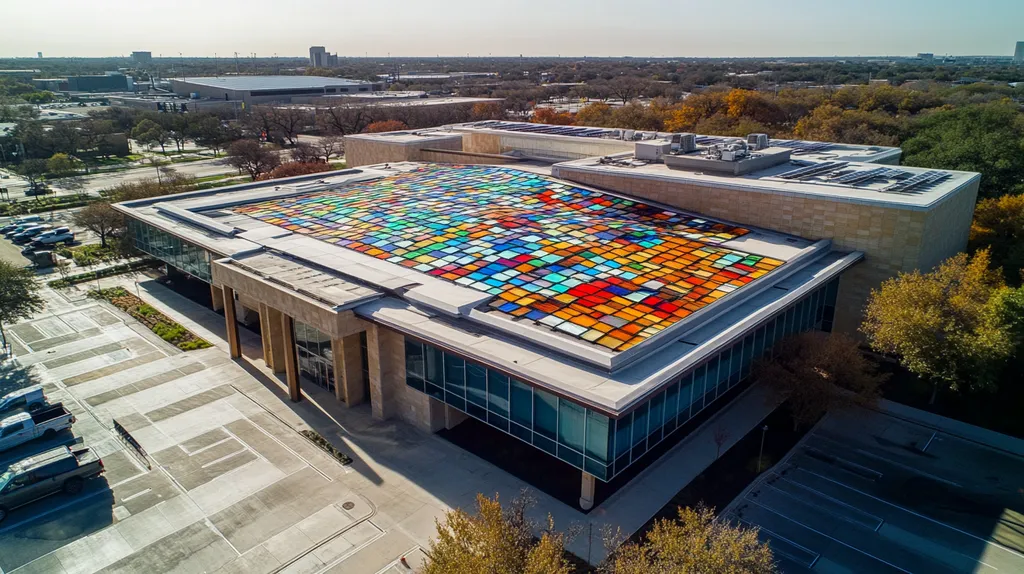When it comes to commercial roof coating projects, safety isn’t just a box to check – it’s a complex symphony where one wrong note can lead to disaster. With workplace falls causing 33% of construction fatalities and OSHA fines reaching $13,653 per violation, the stakes couldn’t be higher.
From misunderstood fall protection requirements to dangerous chemical exposure assumptions, three critical misconceptions are putting workers at risk and costing facility owners millions.
Let’s set the record straight on what current safety regulations actually require, why common shortcuts backfire spectacularly, and how evidence-based solutions are revolutionizing rooftop protection.
SECTION 1: COMMON MISCONCEPTIONS
Picture this: Your commercial roof is like an orchestra conductor, orchestrating protection for everything below. But here’s the shocking truth – three widespread misconceptions about roof coating safety are putting workers at risk and potentially conducting a symphony of disaster. When roofing projects go wrong due to safety oversights, the consequences can hit harder than a timpani crash!
Identical Fall Protection Methods for All Roofs
If you think one-size-fits-all fall protection is the way to go, you might as well believe all shoes come in the same size! Each roof has its own personality, complete with unique challenges and safety requirements.
That flat-as-a-pancake warehouse roof? It needs different protection than your dramatically sloped manufacturing facility. Some roofs might be perfect candidates for guardrail systems, while others are practically begging for personal fall arrest systems.
Even factors like roof age, surface material, and surrounding obstacles can dramatically change the safety equation. It’s like a game of rooftop chess – every piece needs its own strategy!
Treating every roof the same isn’t just incorrect – it’s potentially dangerous. Smart building owners know that customized fall protection strategies are worth their weight in gold (or should we say, worth their weight in premium roofing materials?).
Temporary Weather Delays Are Unnecessary
Think weather delays are just workers being wimpy? Think again! Mother Nature doesn’t play nice with roof coatings, and ignoring her temper tantrums is like trying to paint in a car wash.
High winds can turn tools into projectiles faster than you can say “flying wrench.” Rain doesn’t just make surfaces slippery – it can transform your roof into an impromptu skating rink.
Extreme temperatures aren’t just uncomfortable – they can affect worker performance and safety faster than a hot coffee spill. Heat stress and cold stress are real threats that no amount of “powering through” can overcome.
Smart scheduling around weather conditions isn’t being overly cautious – it’s being business-savvy. After all, redoing a botched coating job costs way more than waiting for better weather!
Generic Hazard Communication Suffices for Roof Coating Chemicals
Thinking all chemicals just need a simple “Warning: Dangerous” sticker? That’s like putting a “Hot” label on everything in your kitchen from ice cream to soup! Each roof coating chemical comes with its own special set of safety considerations.
Different coatings can release various types of fumes, require specific personal protective equipment, and demand unique handling procedures. Some might need special ventilation, while others could react badly to certain materials or conditions.
Proper hazard communication means having detailed protocols, including specific labels, clear signage, and readily available material safety data sheets (MSDS) for every chemical used in roofing work. Workers need to understand exactly what they’re dealing with, not just that it might be dangerous. (source: GSM Roofing & OSHA Guidance)
Skip the detailed chemical safety communication, and you might find yourself in more hot water than a kettle on high boil. Clear, specific hazard information isn’t just good practice – it’s essential for worker safety and project success!
SECTION 2: PRACTICAL IMPLICATIONS
Think your roof is as solid as a rock star’s contract rider? Think again! Just like a backstage pass doesn’t guarantee a great show, assuming your roof can handle anything thrown at it is a recipe for disaster. The stakes couldn’t be higher – falls from roofs orchestrate a tragic 33% of construction-related fatalities. Let’s pull back the curtain on three show-stopping safety issues that could turn your next coating project into a greatest hits collection of costly mistakes.
Structural Integrity Assumptions Versus OSHA Pre-Work Inspection Mandates
Your roof might look ready to rock, but looks can be deceiving! Many building owners skip the opening act – proper structural inspection – and jump straight to the main event of coating application.
Hidden damages can turn your solid-looking roof into a house of cards faster than you can say “structural failure.” Water damage, pest invasions, and years of weather abuse could be staging a sneak attack on your roof’s load-bearing capacity.
Protecting roofing workers requires more than a casual glance and a thumbs-up. OSHA demands frequent and regular inspections of job sites as part of a comprehensive safety program that keeps everyone in tune with potential hazards. (source: OSHA)
Smart facility managers know that skipping these inspections is like trying to perform without a sound check – you’re just asking for trouble!
Substandard Anchorage Systems Compromise Fall Arrest Effectiveness
Would you bungee jump with a rubber band? Of course not! Yet some building owners essentially do just that by cutting corners on anchorage systems for fall protection.
That 5,000-pound minimum support requirement per worker isn’t just a suggestion – it’s the difference between a safe day at work and a tragic headline. Anchorage points need to hit this high note every single time.
Installing budget-friendly but subpar anchors is like putting discount strings on a premium guitar – they’ll break when you need them most. Quality anchorage systems might cost more upfront, but they’re worth their weight in platinum records.
Regular testing and certification of these systems isn’t just paperwork – it’s your safety net’s soundcheck. Make sure every component meets or exceeds standards before the show goes on.
Improper Material Storage Increases Edge Proximity Violations
Storing roofing materials isn’t like arranging backstage equipment – you can’t just pile things wherever they fit! Edge proximity violations turn your roof’s perimeter into a danger zone faster than you can say “incoming bucket.”
Those coating buckets, tools, and materials need their own designated VIP section, well away from the roof’s edge. Creating clear storage zones isn’t just good organization – it’s essential choreography for workplace safety.
Think of your roof edge like a stage diving boundary – cross it without proper protection, and someone’s going to have a bad day. Proper material storage planning keeps everyone and everything safely in their assigned spots.
Remember: A well-organized rooftop is like a perfectly planned concert – when everything’s in its right place, the show goes on without a hitch!
SECTION 3: COST OF MISINFORMATION
Think safety shortcuts on your roof coating project are saving money? Here’s a reality check that’ll make your wallet wince! From regulatory fines that could buy a luxury car to insurance premiums that balloon faster than a bounce house in a hurricane, cutting corners on safety isn’t just dangerous – it’s financial foolishness of the highest order.
Regulatory Fines for Missing Guardrails Exceed Safety System Investments
Playing financial hopscotch with safety regulations? That game ends with a bill that’ll make your accountant cry! A single missing guardrail violation can trigger fines of $13,653 per day – enough to install proper safety systems on multiple roofs.
Safety monitors might sound like an affordable alternative, but OSHA has specific rules about when they can be used. On roofs wider than 50 feet, you’ll need comprehensive fall protection systems that meet strict standards.
Warning lines must be properly placed at least 6 feet from roof edges and flagged every 6 feet – skimp on these requirements and watch those violation notices pile up faster than junk mail. (source: OSHA)
And don’t forget about those sneaky skylights! Their covers must support twice the weight of workers and materials – a requirement that’s often overlooked until it’s too late.
Heat Stress Incidents Drive Insurance Premium Hikes
Think that summer heat wave is just making workers uncomfortable? Think again! Heat stress incidents are premium-hiking machines that can send your insurance costs through the roof faster than a jet-powered hot air balloon.
One serious heat-related incident can trigger premium increases that’ll haunt your budget for years. We’re talking about increases that could fund a small fleet of ice cream trucks!
Smart scheduling around peak heat hours isn’t just worker-friendly – it’s budget-friendly too. Those extra hours of planning can save thousands in premium hikes.
Consider this: The cost of providing proper hydration stations and cooling breaks is pocket change compared to the financial avalanche of heat-stress claims.
Inadequate Training Escalates Workers’ Compensation Claims
Skipping proper safety training is like sending a tightrope walker out blindfolded – someone’s bound to take a costly tumble! Workers’ compensation claims from untrained workers can multiply faster than rabbits at a carrot convention.
Each claim doesn’t just hit your insurance – it’s a financial domino effect. Project delays, replacement worker costs, and legal fees can turn a simple incident into a budget-destroying monster.
Training might seem expensive, but it’s cheaper than therapy (for both your workers and your bank account). Proper safety education programs typically cost less than a single moderate compensation claim.
Remember: Well-trained workers are like safety superheroes – they protect both lives and bottom lines. Investing in comprehensive training programs pays dividends in reduced claims and increased productivity.
SECTION 4: REALITY CHECK
Hold onto your hard hats, property owners! Your rooftop might be harboring more surprises than a magician’s hat. With fall protection exemptions causing confusion, skylight load capacities playing hide-and-seek with safety standards, and anchor point regulations evolving faster than smartphone technology, it’s time for a reality check that could save lives – and your business.
Fall Protection Exemptions: When They Legally Apply (and Don’t)
Think your low-slope roof automatically grants you a fall protection exemption? That’s like assuming your cat’s grace applies to everyone who visits! While some exemptions exist for roofs with minimal pitch, they’re more complex than a chess grandmaster’s strategy.
Even when legal exemptions apply, they come with more strings attached than a puppet show. Weather conditions, work scope, and roof edge proximity can all void these exemptions faster than you can say “OSHA violation.”
Smart property owners treat exemptions like rare diamonds – precious but requiring careful handling. Every exemption needs regular verification against current conditions and work requirements.
Remember: Just because you can skip fall protection doesn’t mean you should. The safest exemption is the one you choose not to take!
Skylight Covering Load Capacity Requirements Versus Real-World Failures
Your skylights might look as solid as Superman’s chest, but without proper load capacity covers, they’re more like tissue paper in a rainstorm. These seemingly innocent roof features can transform into trap doors faster than you can say “workplace incident.”
Every skylight cover must support at least twice the weight of workers, equipment, and materials that might land on it. It’s not just about preventing falls – it’s about preventing disasters. (source: OSHA)
Real-world failures often happen when covers look sturdy but haven’t been properly tested. That pristine-looking cover might have less strength than a chocolate teapot in July.
Regular testing isn’t just paperwork – it’s your insurance policy against gravity’s constant attempts to introduce your workers to the floor below.
OSHA’s Updated Anchor Point Regulations for Modern Roofing Systems
Anchor points aren’t just fancy roof decorations – they’re your workers’ lifelines in the sky. But yesterday’s anchor point might be today’s safety violation, thanks to OSHA’s evolving standards for modern roofing systems.
Those trusty old anchor points that have “always worked fine” might now have more red flags than a maritime signal station. Modern standards demand more than just strong attachment points – they require strategic placement and regular certification.
The days of eyeballing anchor point placement are as outdated as fax machines. Today’s regulations require precise calculations, specific installation methods, and documented testing procedures.
Smart facility managers are treating anchor point updates like smartphone upgrades – staying current isn’t just smart, it’s essential for keeping your safety system from becoming dangerously obsolete.
SECTION 5: EVIDENCE-BASED ALTERNATIVES
Think your roof coating safety plan is as solid as a bank vault? Wake up and smell the chemicals! While you’re playing safety roulette with outdated methods, modern solutions are revolutionizing rooftop protection faster than a squirrel can raid a bird feeder. From smart systems that catch problems before they become disasters to PPE that’s more customized than a celebrity’s smoothie order, it’s time to upgrade your safety game before your current approach springs a very expensive leak!
Hierarchy of Controls for Chemical Exposure
Your coating chemicals aren’t just hanging out up there like sunbathers – they’re potentially dangerous actors that need a strict pecking order of control! Think of it as a safety pyramid where elimination sits at the top like a crown jewel.
Can’t eliminate those pesky chemicals? No problem! Substitution is your next best friend. Trading harsh solvents for water-based alternatives is like swapping a fire-breathing dragon for a friendly puppy – still effective, but way less scary.
Engineering controls are your safety bouncers, keeping dangerous fumes away from workers through ventilation systems that would make a jet engine jealous. Administrative controls orchestrate the whole show, ensuring workers don’t overstay their welcome in chemical hot zones.
And PPE? It’s your last line of defense, not your only strategy. Treating it like your sole protection is like wearing a raincoat in a hurricane – helpful, but definitely not enough!
Climate-Specific PPE Selection Matrices
If you’re handing out the same PPE in Miami as you do in Minneapolis, you might as well be giving snowshoes to a lifeguard! Smart facility managers know that climate-specific gear isn’t just comfortable – it’s crucial for safety and compliance.
Hot climates need cooling vests and breathable materials that work harder than a penguin’s air conditioner. Cold weather calls for insulated gear that would make a polar bear jealous, while wet conditions demand waterproofing that could make a duck envious.
Your PPE matrix should be more detailed than a weather forecaster’s prediction chart. Temperature ranges, humidity levels, and UV exposure all need their own special consideration and corresponding equipment specifications.
Remember: One-size-fits-all PPE is about as effective as a chocolate teapot in July. Your workers deserve better than that melted mess!
Automated Monitoring Systems for Real-Time Roof Integrity Alerts
Welcome to the future, where your roof has more sensors than a spacecraft! Modern monitoring systems are like having thousands of tiny safety inspectors working 24/7, never taking coffee breaks or calling in sick.
These high-tech guardians track everything from moisture levels to structural stress with the precision of a Swiss watch. When something’s not right, they’ll alert you faster than a cat spotting a cucumber!
Think of it as your roof’s social media feed – constant updates about what’s happening up there. Temperature spikes? You’ll know. Moisture invasion? Consider yourself notified. Structural wobbles? The alert’s already in your inbox.
The best part? These systems can predict problems before they turn into disasters, saving you more money than a coupon-clipping champion. It’s like having a crystal ball for your roof, minus the mysterious fog and cryptic predictions!
SECTION 6: TEST AND VERIFY
Think your roof coating project is ready for the big leagues? Not so fast, safety superstar! While you’re trusting those untested anchor points like a tightrope walker with a frayed rope, modern verification methods are revolutionizing rooftop safety faster than a caffeinated squirrel on roller skates. Get ready for a wake-up call that could save your workers’ lives – and your company’s future!
Third-Party Verification of Anchor Point Load Ratings
Your anchor points might look as solid as a heavyweight champion’s jaw, but looks can be deceivingly dangerous! Without proper third-party verification, they’re about as reliable as a chocolate ladder in summer.
These aren’t just random safety spot-checks we’re talking about. Every anchor point must support at least twice the weight of workers, equipment, and materials that might be imposed at any time. (source: OSHA)
Think skipping verification saves money? That’s like thinking you can catch a falling piano with a butterfly net! One failed anchor point can trigger an avalanche of costs that would make your accountant cry.
Smart facility managers treat anchor point testing like annual medical check-ups – regular, thorough, and absolutely non-negotiable. Because when it comes to rooftop safety, “probably fine” is definitely not fine enough!
Infrared Thermography for Curing Validation of Coated Surfaces
Welcome to the CSI: Rooftop Edition, where infrared cameras reveal more secrets than a gossip columnist at a celebrity party! These high-tech tools can spot improperly cured coating faster than a cat spots an open tuna can.
Those invisible hot spots and cold patches? They’re like tiny red flags waving frantically at potential coating failures. Catching them early is like finding a winning lottery ticket before it expires.
Think of infrared scans as your roof’s ultimate truth-teller. They’ll expose those sneaky uncured spots that could turn your perfectly good coating job into next month’s leak festival.
And the best part? This technology is less disruptive than a mouse in a library. No need to shut down operations or tear up perfectly good work – just point, scan, and know!
Calibration Protocols for Slip Resistance Measurement Devices
If you think eyeballing slip resistance is good enough, you might as well be testing ice skating rinks with flip-flops! Modern measurement devices need precise calibration more regularly than a coffee addict needs their morning fix.
These aren’t your grandmother’s friction tests. Today’s devices measure slip resistance with more precision than a Swiss watchmaker, but only if they’re calibrated to perfection.
Skipping calibration checks is like trying to measure rainfall with a broken ruler. Your readings might look good on paper, but they’re about as reliable as a weather forecast from last year.
Regular calibration isn’t just about following rules – it’s about ensuring your slip resistance readings are more trustworthy than a boy scout with a perfect attendance record!
The Bottom Line
With OSHA fines reaching $13,653 per violation and workplace falls causing 33% of construction fatalities, proper roof coating safety isn’t optional – it’s essential for business survival.
Modern roofing demands modern solutions, from automated monitoring systems that predict failures to climate-specific PPE that protects workers in any weather.
Third-party verification, infrared testing, and calibrated measurement tools have transformed rooftop safety from guesswork into science.
The most expensive safety equipment is the one you didn’t install before an accident occurred.
For facility managers and building owners, the message is clear: invest in comprehensive safety systems today, or pay exponentially more in fines, insurance hikes, and worker compensation claims tomorrow.
FREQUENTLY ASKED QUESTIONS
Q. What are the misconceptions about safety for commercial roof projects?
A. Many believe that all roofs require the same fall protection methods. This can lead to dangerous oversights. Each roof has unique needs based on its age, slope, and surface, so customized fall protection strategies are essential to ensure worker safety and project success.
Q. How do OSHA standards impact commercial roof safety?
A. OSHA mandates thorough inspections and safety protocols before projects begin, emphasizing the importance of structural integrity. Failing to comply can lead to fines and increased risks, making pre-work inspections essential for safe operations and long-term viability of any roof coating project.
Q. What are the financial risks of ignoring safety regulations for industrial roofs?
A. Skipping safety measures can result in hefty fines and loss of insurance coverage. The costs associated with injuries or safety violations can quickly add up, making proper adherence to safety regulations not just essential for worker safety, but critical for preserving your budget.
Q. How often should safety inspections be conducted on commercial roofs?
A. Regular inspections are vital; ideally, they should occur annually or after any significant weather events. Inspections help identify potential structural issues, enabling proactive maintenance and ensuring that all safety protocols align with the roof’s current condition and usage.
Q. What modern safety solutions can enhance roof coating projects?
A. Utilizing automated monitoring systems can provide real-time data about structural health. Additionally, selecting climate-specific personal protective equipment ensures worker safety no matter the weather, enhancing overall compliance and minimizing risk on roofing projects.
Q. How can workers ensure proper training for roof safety?
A. Employers should provide comprehensive training programs tailored to roof work hazards and safety protocols. Investing in ongoing education ensures workers are well-prepared, minimizing risks and promoting a culture of safety within the commercial roofing environment.
Q. What are the best practices for storing materials on a commercial roof?
A. Storing materials away from roof edges is crucial to prevent accidents. Designating clear storage zones keeps materials organized and reduces edge proximity violations. Proper planning ensures that everyone can work safely without the risk of falling hazards.











